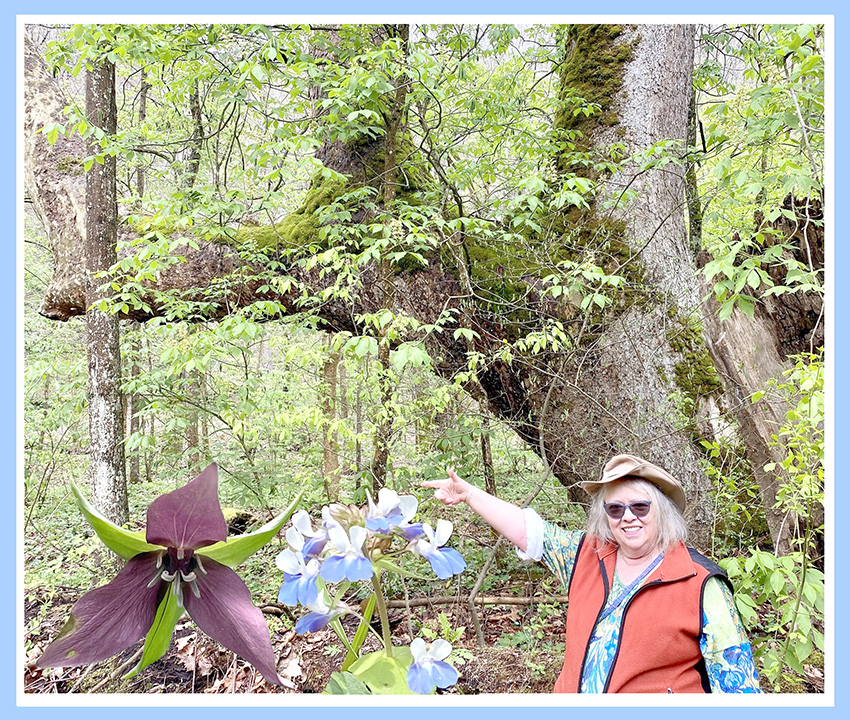When Easter came early on March 31, I was more than ready to take a Sunday drive to State Game Lands 302 just to see, pardon the pun, what’s up. Ramps, those frisky aromatic wild leeks that spring festivals love to love, were showing, and my mouth was watering. I was ready to snack my way into spring, ready to search out nettles and dandelion greens and check along certain back roads where the wild ramps grow. The annual Spring Fling Wildflower and Bird Walk isn’t until May 5, but today I was restless, eager to see how well steep, muddy Smokey Row Road had survived the winter. (Spoiler alert—very well, thank you! The slip was being repaired when I drove down, and the road will nicely graded by May. Come and enjoy nature at its finest!)
Enlow Fork of Wheeling Creek flows between Greene and Washington counties through a sheltered valley that is deep, steep and utterly gorgeous in springtime. Birders and nature lovers have been pilgrimaging here for decades, and the stream is stocked for trout. The creation of State Game Lands 302 preserved the area’s unique, wildlife-friendly habitat for the public to enjoy. Hundreds of years ago, indigenous tribes trekked through these hunting grounds, as the humongous sycamore “trail marker tree” that sits on the Washington County side of the creek can testify.
When settlers came, they farmed the broad bottomland. All that remains now are some foundation stones and clusters of non-native flowers—mainly daffodils—that show where the Fisher family farmhouse once looked down on the creek.
Smokey Row Road once connected Enlow valley to the rest of the world, from Walker Hill Road to the road to West Finley. Now it dead ends where it once crossed the creek for the second time. The remaining bridge spans a great stretch of riffles that are perfect for fly-fishing, surrounded by sycamore and buckeye trees. After the stream is stocked in mid April, wildflowers—trillium, squirrel corn, Dutchman’s breeches, trout lily, toad flax, phlox, geranium, Virginia bluebells, Greek valerian, larkspur, blue eyed Mary—carpet the valley. Today, early spring beauties and purple horse nettle are busy pushing through the leaf litter. But a single cluster of purple phlox beside a sycamore and one half-opened trillium against the bank let me know that spring was getting ready for the show. High above the trees, an eagle circled. Somewhere nearby, its chicks are already hatched and hungry. Soon the forest canopy would be filled with other nesters, including the elusive southern warblers that venture this far north to breed. When birders descend on Enlow valley on May 5, they will be busy counting those species for Pennsylvania Bird Atlas 3, a count that will go on statewide for the next five years.
When the first five-year Atlas happened in the 1980s, secluded Enlow valley was discovered to be a priority nesting area, especially for warblers. From then on, the annual wildflower walk slash bird watch became a popular event.
When the Atlas 2 Bird Count finished up in 2009, the differences in nesting populations in 20 years showed species and population decline throughout the state as land usage continued to change.
Those first two counts depended on reports being filed on paper, using cumbersome maps, gridded to mark the 77 three-mile-square “blocks” that make up Greene County’s count zones.
Today, this data can is filed online and Atlas 3 has added a winter count to further monitor the health of our native species.
Members of the Ralph K. Bell Bird Club and other regional clubs and organizations that are familiar with the ins and outs of becoming citizen scientists will be at Enlow on May 5 to answer questions about Merlin and eBird, two aps created by Cornell University that turn smart phones into data gathering tools.
Support for this important environmental project comes from the Pennsylvania Game Commission, Hawk Mountain Sanctuary and Audubon.
For those new to birding, Merlin can record unfamiliar bird songs, then send them to more experienced birders to verify and document. Atlas 3 coordinator Amber Wiewel told me this and more when I contacted her at Hawk Mountain Sanctuary in Kempton, PA.
Wiewel agrees that Atlas 3 is a significant chance for local universities, school districts, scout groups and libraries in our area to include students for the next five years. “We are so excited to have the support of birders and educators in Greene County who are not only contributing data to the Atlas but also incorporating birding and Atlasing into their educational programs to help produce the next generation of birders and environmentalists!”
Birders will be in the field as early as 7:30am. Dress for the weather, bring your birding gear, including lunch and a folding chair. Guided wildflower walks begin at 10am. Wheeling Creek Watershed Conservancy will have tables set up with snacks, drinks and information about Atlas 3, along with and seeds and suggestions for establishing pollinator pathways with native plants. Each year, WCWC funds the portable toilet that is left onsite for the weekend and throughout the following week to accommodate visitors who come on their own time to visit Enlow.
Google: pa atlas 3 for a wide range of webpages and organizations that are connected to this project. Email Ralph K Bell Bird Club, rkbellbirdclub@yahoo.com to participate in the ongoing Washington/Greene County counts.
Directional signs will be up from Waynesburg and directions can also be found online at enlowfork.tripod.com or call 724-833-2622.
